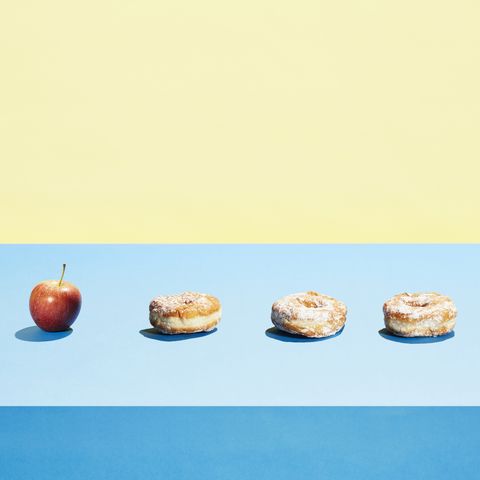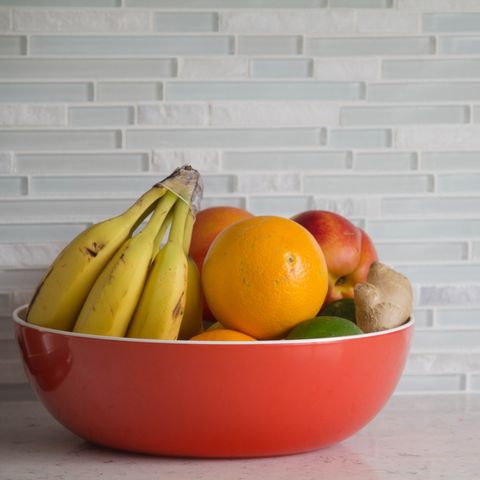You’ve been hearing it for forever: Eating a diet rich in fruits and vegetables can protect you from heart disease, diabetes, some cancer, and even obesity.
And you don’t even have to eat that much fruit to reap the benefits, at least according to the 2015-2020 Dietary Guidelines for Americans. Uncle Sam recommends just 1 ½ to 2 cups of fruit daily.
Right now—and I’m being completely honest with you here—I just cut up a medium apple and that was about a cup of fruit.
Yet guess how many American adults actually eat 1 ½ to 2 cups of fruit daily?
Guess.
Only 12.2 percent.

Feifei Cui-Paoluzzo
That’s according to a 2018 Centers for Disease Control and Prevention 2018 report, which does go on to describe that one of the reasons this statistic is so low is due to a lack of availability of fresh produce in some areas.
Those new U.S. Dietary Guidelines are a little less forgiving: “A wide variety of fruits are available in the U.S. marketplace, some year-round and others seasonally. Strategies to help achieve this shift include choosing more fruits as snacks, in salads, as side dishes, and as desserts in place of foods with added sugars, such as cakes, pies, cookies, doughnuts, ice cream, and candies.”
And herein lies the problem. No one, myself included as a longtime Food & Nutrition Editor of Men’s Health, is going to eat an apple—or any fruit—in place of a doughnut.

Richard Drury
Doughnuts are delicious in ways that an apple could never be—and vice versa. Replacing a doughnut with an apple isn’t going to happen.
Here’s a more realistic tact to take, one that I’ve used my entire life to help ensure that I’m eating at least one piece of fruit every day.
It involves just three steps.
Step 1: Buy the Right Kinds of Fruit

Yunio Baro Gomez / EyeEm
“You can’t eat 100 percent of the fruit you don’t buy.” —Wayne Gretzky (maybe)
I tend to purchase fruit that has a shelf-life of a week or more and requires minimal prep. This is usually apples, bananas, grapes, pears, and, if they’re in season, peaches and those little easy-peel clementines. Every time I go to the grocery store I pick them up. They’re not even on my list. It’s a default that they’re always in the cart.
Call these Easy Fruits.
Now, there’s nothing wrong with cantaloupe or mangoes or watermelon or papaya or strawberries. These fruits are loaded with fiber and antioxidants and will surely help you reach your 1 ½-cup minimum for the day. But they’re also fruits that either require refrigeration and/or preparation to enjoy.
And this is important, because…
Step 2: Display the Fruit Where You Can’t Ignore It

Nancy Rose
I actually have, not one, but two fruit bowls sitting on the countertop between my sink and stove. This is where the fruit always goes. There’s fruit in the fridge, but I hardly ever eat that fruit unless I’m using it to top my yogurt or I’m desperately hungry for a fruit-based snack.
If I see the fruit, I’m more likely to eat the fruit.
Call these Obvious Fruits.
And this is important, because…
Step 3: Eat Fruit While Cooking Breakfast

Tom Werner
It could be during preparations for lunch or dinner, too, but for me breakfast has always felt like the best fit.
After I’ve had my coffee, but before I’ve finished making my scrambled eggs, I snack on one of the Easy, Obvious Fruits within reach.
I eat my fruit while the butter is melting in the pan for the eggs, but that’s just me.
Maybe there’s a similar break in your cooking that occurs when you’re flipping your flapjacks, waffling your waffles, or, hell, microwaving your breakfast burrito. Wherever you find that dead space, fill it with fruit.
Then, before I know it, I’ve eaten one piece of fruit before I’ve sat down to breakfast.
Even if that breakfast includes a doughnut.
Source: Read Full Article